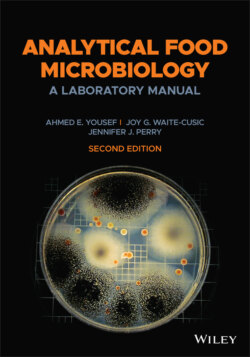Читать книгу Analytical Food Microbiology - Ahmed E. Yousef - Страница 48
METHODS
ОглавлениеImportant Notes:
Aseptic technique is expected in this and all other exercises. This includes, but is not limited to working in proximity of a lit Bunsen burner, flaming the mouth of the medium container after removing the cap, protecting the sample during processing against contamination from the work environment or the analysts, and using common sense in handling sterile and contaminated tools.
Wearing gloves and goggles is needed for personal safety.
1 Safety and Laboratory Etiquette ComplianceRead and follow laboratory safety guidelines described in Chapter 1.Give special attention to the “practical aspects” described in that chapter.
2 Sample InformationPick the food sample assigned to the group.Record any pertinent sample information.
3 Sample Cutting (group task)Using the plan prepared by the group in advance, cut the food sample (laboratory sample) into small pieces suitable for withdrawing 10‐g analytical samples. Use the appropriate sample preparation equipment provided.Note: The analytical sample should represent the laboratory sample accurately.
4 Withdrawing the Analytical Sample (individual task: one sample per group member)Using the sterile beaker, weigh out one 10‐g analytical sample.Aseptically transfer the analytical sample from the beaker into a sterile stomacher bag.
5 Homogenization (individual task)Add the 90‐ml diluent to the contents of the stomacher bag. Carefully push most of the air out of the bag and close the bag with the provided fastener before stomaching.Homogenize the sample in the stomacher for two min. The contents of the stomacher bag (i.e., the homogenized sample) is the 1/10 (10–1) dilution of the original analytical sample.
6 Preparing Decimal Dilutions (individual task, see Figure 2.3)Label three dilution tubes that will become the 10–2, 10–3, and 10–4 dilutions.Using the serological pipette, transfer 1 ml of food homogenate into the diluent tube labeled 10–2. Vortex tube contents briefly.Using the automatic pipetter, transfer 1 ml of the 10–2 tube into the tube labeled 10–3. Vortex tube contents briefly.Using the automatic pipetter, transfer 1 ml of the 10–3 tube into the tube labeled 10–4. Vortex tube contents briefly.
7 Recording Observations (group task)Report work progress to instructor.
